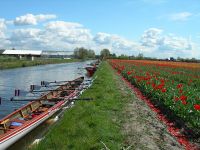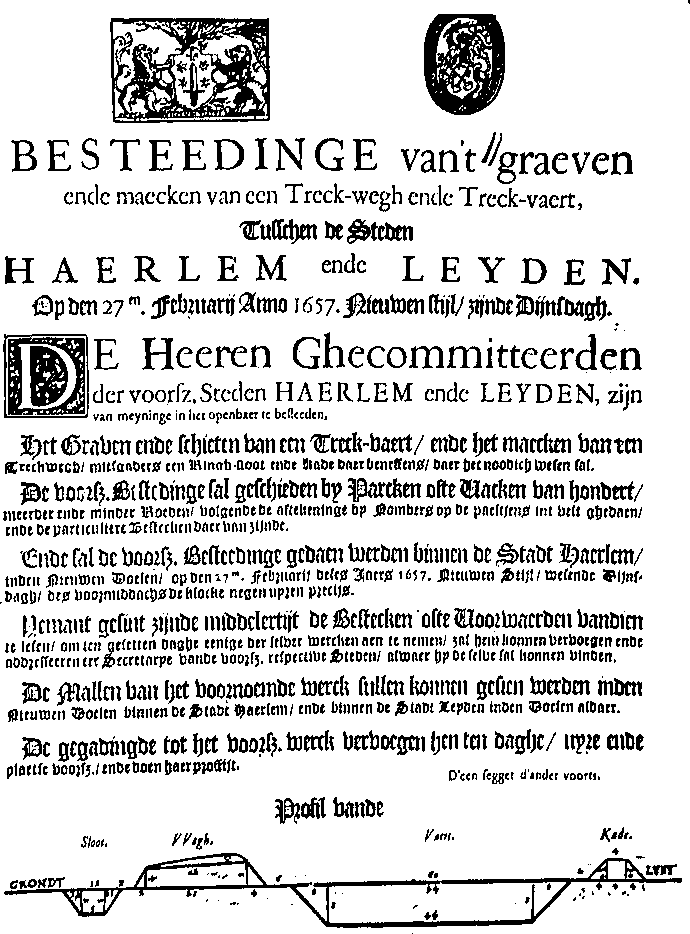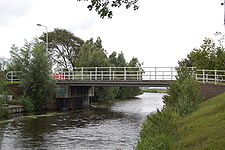
Leidsevaart
Encyclopedia

Canal
Canals are man-made channels for water. There are two types of canal:#Waterways: navigable transportation canals used for carrying ships and boats shipping goods and conveying people, further subdivided into two kinds:...
between the cities of Haarlem
Haarlem
Haarlem is a municipality and a city in the Netherlands. It is the capital of the province of North Holland, the northern half of Holland, which at one time was the most powerful of the seven provinces of the Dutch Republic...
and Leiden in the Netherlands. It was dug in 1657, making it one of the oldest canals in the Netherlands. It was the major means of transport between Leiden and Haarlem for almost two centuries until the rail connection was established in the 19th century. The original stops along the railroad mirrored the toll bridges of the canal.
The canal runs through or borders the municipalities of Haarlem, Heemstede
Heemstede
Heemstede is a municipality and a town in the Netherlands, in the province of North Holland.-History :Heemstede formed around the Castle Heemstede that was built on the Spaarne River around 1286. Before 1296, Floris V, Count of Holland, granted Heemstede as a fiefdom to Reinier of Holy...
, Bloemendaal
Bloemendaal
Bloemendaal is a municipality and a town in the Netherlands, in the province of North Holland. According to the Dutch Central Statistical Bureau, Bloemendaal is the wealthiest place in the Netherlands.-Population centres :...
, Bennebroek
Bennebroek
Bennebroek is a town and former municipality in the Netherlands, in the province of North Holland, now part of Bloemendaal municipality. Before its merger, it was the smallest municipality in the Netherlands, covering an area of only 1.75 km².-History:...
, Hillegom
Hillegom
Hillegom is a town in the western Netherlands, in the province of South Holland. The municipality covers an area of 13.48 km² of which 0.61 km² is water....
, Noordwijkerhout
Noordwijkerhout
Noordwijkerhout is a town and municipality in the western Netherlands, in the province of South Holland. The municipality covers an area of 23.40 km² and had a population of 15,121 in May 2006...
, Lisse
Lisse
Lisse is a town and municipality in the western Netherlands, in the province of South Holland. The municipality covers an area of 16.11 km² of which 0.41 km² is water. Its population is 21864...
, Teylingen
Teylingen
Teylingen is a municipality in the province of South Holland, the Netherlands. It was created on January 1, 2006, through the amalgamation of Sassenheim, Voorhout, and Warmond...
, Oegstgeest
Oegstgeest
Oegstgeest is a town and municipality in the province of South Holland in the western Netherlands. Its population was 22,576 in 2008.-Location :...
, and Leiden.
History

Haarlemmertrekvaart
The Haarlemmertrekvaart is a canal between Amsterdam and Haarlem in the province of North Holland, the Netherlands. It was dug in 1631, making it the oldest tow-canal in Holland...
(Haarlem's Pull-Canal) connecting Amsterdam
Amsterdam
Amsterdam is the largest city and the capital of the Netherlands. The current position of Amsterdam as capital city of the Kingdom of the Netherlands is governed by the constitution of August 24, 1815 and its successors. Amsterdam has a population of 783,364 within city limits, an urban population...
to Haarlem. Travel on these canals was done by trekschuit
Trekschuit
Trekschuit, literal translation 'tugboat', is an old style of horse-drawn boat specific to the Netherlands where it was used for centuries as a means of passenger traffic between cities along trekvaarten, or tow-canals.-History:...
for people, and by barge
Barge
A barge is a flat-bottomed boat, built mainly for river and canal transport of heavy goods. Some barges are not self-propelled and need to be towed by tugboats or pushed by towboats...
for goods, which were pulled by animals (and sometimes by man-power) on a towpath
Towpath
A towpath is a road or trail on the bank of a river, canal, or other inland waterway. The purpose of a towpath is to allow a land vehicle, beasts of burden, or a team of human pullers to tow a boat, often a barge...
along the canal's edge. It was reliable, comfortable and cheap. The speed was about 7 kilometers per hour, which was faster than walking, and more comfortable than by coach
Stagecoach
A stagecoach is a type of covered wagon for passengers and goods, strongly sprung and drawn by four horses, usually four-in-hand. Widely used before the introduction of railway transport, it made regular trips between stages or stations, which were places of rest provided for stagecoach travelers...
. Many wealthy Amsterdam families had summer homes along the Leidsevaart or Spaarne
Spaarne
The Spaarne is a river, in North Holland, Netherlands. This partially canalized river connects the Ringvaart to a side branch of the North Sea Canal. It runs through Haarlem, Heemstede, and Spaarndam....
River, and they arrived with their heavy belongings by barge, often being pulled or sailed all the way to their door, as most summer estates
Estate (house)
An estate comprises the houses and outbuildings and supporting farmland and woods that surround the gardens and grounds of a very large property, such as a country house or mansion. It is the modern term for a manor, but lacks the latter's now abolished jurisdictional authority...
had canals dug for this purpose. Even today the old canals are visible though probably too shallow for a trekschuit.
The canal was kept up with toll money and taxes. Many estate owners spent money on making canal spurs to their doorstep and then had to pay taxes for fishing rights, "swan" keeping rights, or general canal use. The same was true for landowners whose lands were seized for digging the canal. They were compensated for the loss of the land strip taken up by the canal, but they had to pay for a bridge themselves. Trekschuit owners also had to pay taxes for using the canal. Taxes for traffic in people (by trekschuit) was heavier than taxes for traffic in goods (by barge).
After the train line Leiden - Haarlem (Oude Lijn) was built, many of these extra costs made trekschuit travel unattractive, and the canal quickly fell in popularity from 1842 onwards. Due to the many drawbridges along its course that are no longer in operation, the Leidsevaart is unsuitable for boat traffic nowadays and therefore has fallen mostly in disuse.
Estates along the Leidsevaart

- Oud PoelgeestOud PoelgeestOud Poelgeest is castle in Oegstgeest, north of Leiden, that was the former home of the Dutch scientist Herman Boerhaave . He was a Dutch humanist and physician of European fame.-History:...
, home to Herman BoerhaaveHerman BoerhaaveHerman Boerhaave was a Dutch botanist, humanist and physician of European fame. He is regarded as the founder of clinical teaching and of the modern academic hospital. His main achievement was to demonstrate the relation of symptoms to lesions... - KeukenhofKeukenhofKeukenhof , also known as the Garden of Europe, is situated near Lisse, Netherlands, and is the world's largest flower garden...
, former estate and scene of a yearly flower show in the Netherlands - Huis te Vogelenzang (reachable via a rather long canal spur that continued straight when the canal approached HeemstedeHeemstedeHeemstede is a municipality and a town in the Netherlands, in the province of North Holland.-History :Heemstede formed around the Castle Heemstede that was built on the Spaarne River around 1286. Before 1296, Floris V, Count of Holland, granted Heemstede as a fiefdom to Reinier of Holy...
) - The HartekampHartekampHartekamp, or Hartecamp, is the name of a villa in Heemstede, the Netherlands, on the Bennebroek border. It was once the summer home of George Clifford, who employed Linnaeus in 1737 to write his Hortus Cliffortianus, a detailed description of the gardens of Hartecamp.-History:The house was built...
, home to George Clifford and famous for its Hortus CliffortianusHortus CliffortianusThe Hortus Cliffortianus is a work of early botanical literature published in 1738.The work was a collaboration between Carl Linnaeus and Georg Dionysius Ehret, financed by George Clifford in 1735-1736. Clifford, a wealthy Amsterdam banker was a keen botanist with a large herbarium and governor of...
published by Linnaeus - Huis te ManpadHuis te ManpadThe Huis te Manpad, Heemstede is an historical villa and former summer home of Jacob van Lennep, bordered by the Leidsevaart, the Manpadslaan, and the Herenweg. It neighbors the estate of Hartekamp, famed for the gardens described by Linnaeus. Both estates still have trees and other flora dating...
, at the corner of the Manpadslaan and located at the toll bridge to Heemstede - Leyduin, across from the Manpad
- Meer en Berg, at the end of the Manpad on the East side (now part of Groenendaal ParkGroenendaal ParkGroenendaal park lies at the center of Heemstede, Netherlands.The park includes the grounds of old Heemstede country estates Bosbeek, and Meer en Berg. Along its western borders are the old Heemstede country estates Hartekamp, Huis te Manpad, and Iepenrode. On the eastern boundary is the city...
) - Iepenrode, across from Groenendaal (now part of Groenendaal park)
- BerkenrodeBerkenrodeBerkenrode is a former village in the Dutch province of North Holland. It is first mentioned as a 'Heerlijkheid' in 1284, though first mention of a castle is found much later in 1466. Thi sis because the family Van Berkenrode preferred to live on the Grote Markt in Haarlem...
, across from the Haarlem toll bridge (today the location of Heemstede-Aerdenhout railway stationHeemstede-Aerdenhout railway stationHeemstede-Aerdenhout is a railway station in Heemstede and Aerdenhout, the Netherlands. The station opened on 1 October 1891 and is located on the site of the old Toll house for the Leidsevaart canal, which still flows next to the station from Haarlem to Leiden. This canal still follows the Oude...
) - Alverna, a cloister across from Berkenrode

